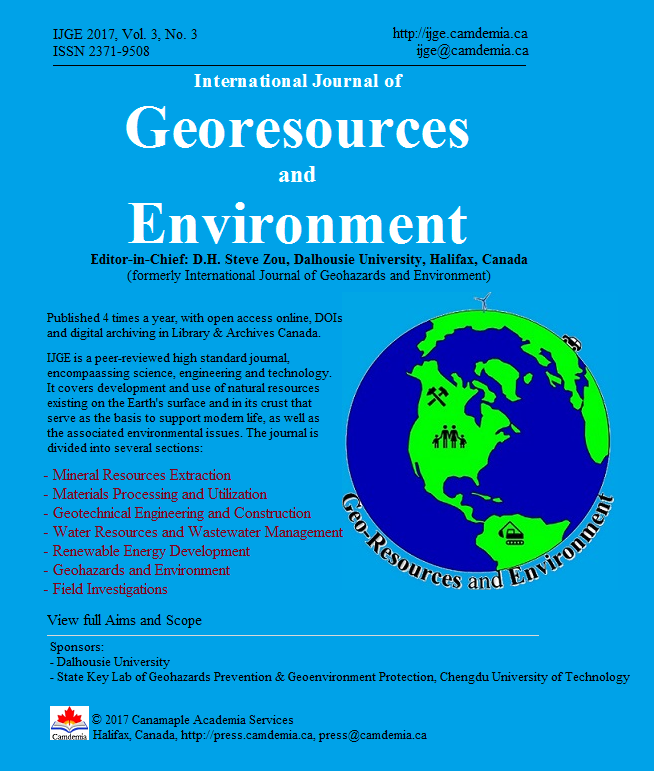Estimation of Quality Factor (Qβ) Using Accelerograms of Ahar-Varzaghan Earthquakes, Northwestern Iran
DOI:
https://doi.org/10.15273/ijge.2017.03.008Keywords:
Attenuation, Qβ (f), Inversion, Ahar-Varzaghan Earthquake, NW-IranAbstract
High-frequency strong-motion data of two recent major earthquakes in the Ahar-Varzaghan region, Northwestern Iran, have been used to determine shear-wave quality factor (Qβ (f)) and seismic source parameters. Data from a local array of 12 stations, two main shocks (Ahar-Varzaghan doublet earthquakes (Mw 6.4 and 6.3) on August 11, 2012), and 38 aftershocks of magnitude 4.1 – 5 were analyzed. The classic Brune model is used to predict the shape of the source spectrum and to provide scaling relationships between spectral and source parameters. In order to obtain reliable estimates of the source spectrum, the effects of attenuation need to be estimated and corrected. By using an inversion algorithm in this work, an average relation in the form Qβ = (114 ± 21) f (0.90 ± 0.07) is obtained. The best fit theoretical spectrum provides final values of source parameters, i.e. seismic moment Mo and corner frequency fc as 3.19 à— 1025 dyne cm and 0.69 Hz, respectively, for the first event. Obtained Q(f) relationship suggests a low Qo value (< 200) and a high n value (> 0.8) for high heterogeneous, tectonically and seismically active regions.Downloads
Published
Issue
Section
License
Copyright, Terms and Conditions
The International Journal of Geohazards and Environment (the Journal) is published by Canamaple Academia Services (the Publisher) online with open access, under a Creative Commons Attribution-Noncommercial license (CC-BY-NC) (http://creativecommons.org/licenses/by-nc/4.0/). Authors (the Authors) submitting papers (the Work) for publication in the Journal automatically agree to the following terms and conditions.
1. Under the license (CC-BY-NC), Authors give permission for others to share and reuse the Work, as long as the original source and author(s) are properly cited (i.e. a complete bibliographic citation and link to the Journal website) and the material is not used for commercial purposes. Any sharing or reuse must however indicate the original CC-BY-NC license terms of the work.
2. Authors transfer and assign to the Publisher all copyright in and to the Work. However Authors retain all proprietary rights except the copyright, related to the Work and also retain the rights a) to use, reproduce, distribute, and publicly display the Work in any medium in connection with the Authors‘ academic and professional activities, such as teaching, presentations and lectures, b) to create derivative works from the Work and to make full use of the Work in future research and publications, c) to authorize others to make any non-commercial use of the Work, d) to make both the pre-published and final-published versions available online in institutional and/or disciplinary repositories or on their own websites with a citation and link to the original paper published in the Journal.
3. Authors warrant that the Work is their original work, it is not copied from anywhere or anyone else, they are totally responsible for the authenticity, originality, validity and accuracy, and the facts and views are their own, that the Work contains no matter which is defamatory or infringes any literary or proprietary rights, intellectual property rights, or any rights of privacy, and that the Work has not been simultaneously submitted to any other journals or publishers. Authors further agree that their manuscripts whether accepted or rejected will not be returned and the rejected manuscripts will be disposed at the journal editor's discretion.
Disclaimer: The Publisher, the Journal and the editors accept no responsibility for statements or opinions expressed by authors. Use of information and materials in the Journal is the sole responsibility of users.


